Chronological list of top rookie seasons in Phillies history


The Phillies continue their free agent quest to bolster the roster. Having already added Andrew McCutchen and Jean Segura, the big names of Manny Machado and Bryce Harper are still on the radar.
Adding either would complete a very successful off season, adding to Aaron Nola and Rhys Hoskins, who was a rookie sensation in 2017.
Taking a look back, here are the top rookie seasons since the Rookie of the Year was first awarded in 1947.
Richie Ashburn (1948, center field, ROY voting: 3rd)
Ashburn was a 21-year old speedster out of Nebraska who patrolled center field during his 1948 rookie campaign. His rookie season was so good that he was named an All-Star and finished 11th in the MVP voting.
Ashburn hit .333 with a .410 on-base percentage, .810 OPS and led the league in stolen bases with 32. His efforts placed him third in the Rookie of the Year vote.
He was a key member of the 1950 NL Championship team, leading the league in triples with 14. Ashburn led the league in hits the following season with 221, in 1953 with 205, and in 1958 with 212. He hit .300 or better nine times with a career-high .350 in 1958. He also led the league in walks four times and on-base percentage four times and was a five-time All-Star.
Ashburn played for the Phillies through the 1959 season, with the Cubs in 1960 and 1961 before by selected by the Mets in the expansion draft of 1962. In his final season, Ashburn was an All-Star, hitting .306 in 135 games.
Ashburn ranks third in franchise history in hits and walks and fourth in runs scored. He retired with 2,574 hits, 1322 runs, and a .308 batting average.
Known as “Whitey”, Ashburn had a successful post-playing career, teaming with Harry Kalas to form one of the best baseball broadcasting duos in history. Ashburn was elected to the Hall of Fame in 1995 and passed away in 1997.

Dick Allen (1964, third base, Rookie of the Year)
Allen was one of the top home run hitters of his era and many believe he should be in the Hall of Fame. After a cup of coffee in 1963 in which Allen had 24 at-bats, he displayed his power in a big way his rookie season. In 1964, Allen hit .318 with 38 doubles, a league-leading 13 triples, 29 home runs, and 91 RBI. He also led the league in runs scored with 125, earning him 7th most votes for MVP and the Rookie of the Year award.
He made three consecutive All-Star appearances from 1965 through 1967, setting a career high of 40 home runs in 1966. Allen surpassed thirty home runs in both 1968 and 1969 in his final two seasons of his first stint in Philadelphia.
Allen was an All-Star with the Cardinals in 1970, hitting 34 home runs and knocking in 101. After a season in Los Angeles, Allen had three consecutive All-Star seasons with the White Sox, earning the MVP in 1972. He led the league in home runs, RBI, on-base percentage and slugging percentage. Allen led the league in home runs in 1974 with 32, his sixth and final season with at least 30 home runs.
Returning to Philadelphia in 1975, Allen was a shell of his former greatness. Over the next two seasons, Allen hit 27 home runs in 204 games with a career-low .233 batting average in 1975. He finished his career in Oakland in 1977, adding five home runs in 200 at-bats.
Allen retired with a .292 average, 351 home runs, 1119 RBI, 1099 runs scored and a slugging percentage of .534.
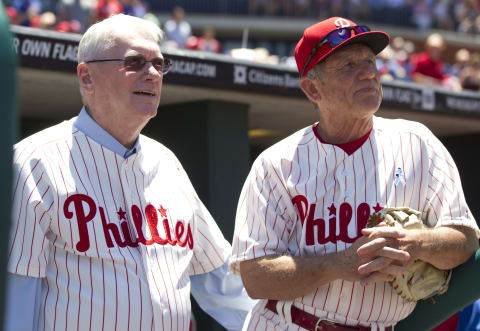
Larry Bowa (1970, shortstop, ROY voting: 3rd)
Bowa began his Major League career during a down period in the franchise’s history. However, he became a major building block that eventually turned the cellar dwellers to one of the top teams in baseball and ultimately a World Series in 1980.
During his rookie season, Bowa hit a modest .250 with 17 doubles, six triples. 34 RBI and 21 stolen bases. However, he started 141 games at shortstop committing only 13 errors for a fielding percentage of .979, well above the league average of .965. Bowa’s efforts were good enough for a third place finish in Rookie of the Year voting.
Although not outstanding with the bat, Bowa led the league in triples in 1972 with 13 and hit a career best .305 in 1975. A good base stealer, Bowa surpassed 20 thefts nine times and and 30 stolen bases three times.
Bowa made five All-Star teams and won the Gold Glove award twice, although his career fielding percentage for a shortstop of .980 is one of the best of all-time.
He was traded to the Cubs along with Ryne Sandberg for shortstop Ivan DeJesus. After more than three seasons with the Cubs, Bowa finished his career in 1985, appearing in 14 games for the Mets. Bowa ranks sixth in franchise history in hits and stolen bases and seventh in triples. He retired with .260 average, 2191 hits and 318 stolen bases.
Bowa went on to manage the Padres before returning to the Phillies as third base coach from 1988 through 1996, manager from 2001 to 2004 and bench coach from 2014 through 2017. He also spent time as a studio analyst for the MLB Network from 2011-2013 and is now Phillies Senior Advisor to the General Manager.
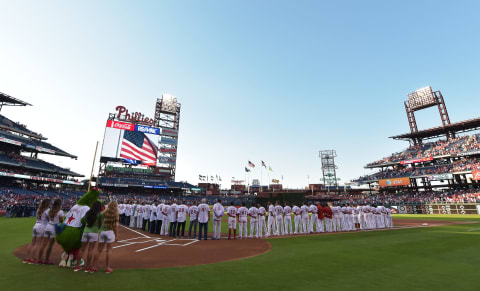
Willie Montanez (1971, center field, ROY voting: 2nd)
Montanez made his Major League debut as an 18-year old with the California Angeles in 1966. Appearing in eight games, he struck out twice in two at-bats and scored two runs. He didn’t make a big league appearance again until 1970 with the Phillies, hitting .240 in 18 games. Maintaining rookie status in 1971, Montanez had his best season of his career. In 158 games, he belted 30 home runs and knocked in 99. Those numbers were good enough for second in Rookie of the Year voting.
He led the league in doubles with 39 the following season and hit .304 in 1974. In May of 1975, he was traded to the San Francisco Giants for Garry Maddox. Montanez hit .305 with 85 RBI for the Giants that season and .309 in 60 games in 1976 before being traded to the Braves. Montanez bounced around the league, playing for the New York Mets, Texas Rangers, San Diego Padres, Montreal Expos and Pittsburgh Pirates before finishing his career with the Phllies in 1982.
Montanez had his best stretch from 1975 through 1978 in which he knocked in 349 runs with a career high 101 in 1975. He made his only All-Star appearance as the member of the Braves in 1978, when he hit .287 with 31 doubles and 20 home runs. Montanez also earned MVP votes for his play in 1975 and 1976.
While starting out in center field, Montanez made his name defensively as one of the best at first basemen in the league, leading the league in assists in 1975, 1976 and 1978. He holds a career fielding percentage at first base of .992 in 1164 games.

Bob Boone (1973, catcher, ROY voting: 3rd)
Boone has a very successful 19-year playing career which included four All-Star appearances and seven Gold Glove awards. It all began with a 16 games with the Phillies in 1972 in which Boone hit .274 with a home run and four RBI. Maintaining his rookie status for 1973, Boone played in 145 games, batting .261 with 20 doubles, 10 home runs, 61 RBI and only 36 strikeouts in 521 at-bats. Defensively, he threw out 47 percent of would be base stealers and had a .990 fielding percentage. Boone’s efforts earned him third place in Rookie of the Year voting.
He made his first of three All-Star appearances in a Phillies uniform in 1976, hitting .271 with 54 RBI. Boone had his best three year stretch offensively from 1977 through 1979, averaging 11 home runs, 62 RBI and .285 batting average. He also earned two Gold Gloves during that stretch.
Boone was behind the plate for the Phillies first World Series championship in 1980 and played with the team through the 1981 season. He spent the next six seasons with the Angels, selected to the All-Star team in 1983 and three consecutive Gold Glove awards from 1986-1988.
He finished his career with the Royals, still starting at the age of 41 in 1989. He played well enough defensively to earn his final Gold Glove award. Boone retired following the 1990 season, batting .239 in 40 games.
Boone retired with a .259 average with 65 home runs in 1125 games in a Phillies uniform. In 19 seasons, he appeared in 2264 games, hitting .254 with 1838 hits, 105 home runs and 826 RBI. He ranks third in Major League history in games caught with 2225, trailing only Ivan Rodriguez and Carlton Fisk.
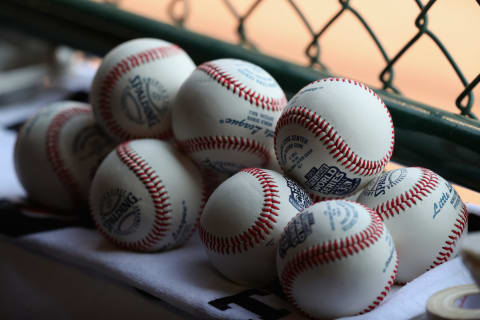
Lonnie Smith (1980, left field, ROY voting: 3rd)
Smith spent minimal time with the Phillies in 1978 and 1979 as a young, speedy outfielder. He appeared in 34 games during that time, going 5-for-34 with six stolen bases in seven attempts. Smith blossomed during his rookie season in 1980, hitting .339 with 33 stolen bases in 100 games. In doing so, Smith received enough votes to finish third for Rookie of the Year.
The following season, Smith hit .324 with 21 stolen bases in 60 games. Despite showing some promise, he was traded in November of 1981 for pitcher Lary Sorensen and eventually landed the Phillies catcher Bo Diaz. Smith was an All-Star in 1982 and second in MVP voting, hitting .307 with a league-leading 120 runs scored and 68 stolen bases. He had another outstanding season in 1983, hitting .321 with 43 stolen bases and swiped 50 in 1984.
Smith was traded to the Royals during the 1985 season and hit .333 in the World Series against his former team, leading the Royals to a seven-game upset. After another solid season in 1986, Smith’s playing time dropped to just 167 at-bats in 1987 before signing with the Braves in 1988.
Smith rebounded in 1989 to hit .315 with career highs in home runs (21) and RBI (79), while leading the league in on-base percentage at .415. He surpassed the .300 mark again in 1990 and played with the Braves through the 1992 season.
He saw limited playing time with the Pirates and Orioles in 1993 and 1994 before retiring with 1488 hits, a .288 average and 370 stolen bases.

Juan Samuel (1984, second base, ROY voting: 2nd)
Samuel showed promise during an 18 game stretch for the 1983 NL Champions. He hit .277 with a double, two triples, two home runs and three stolen bases in 65 at-bats. In 1984, Samuel had a career best 72 stolen bases and 19 triples, leading the league. In addition, Samuel hit .272, scored 105 runs, hit 36 doubles and 15 home runs. Those efforts were good enough for an All-Star appearance and second in Rookie of the Year balloting.
His rookie season started the best four-year stretch of his career. During that time, Samuel had over 30 doubles and ten triples. He set a career-best 113 runs, 28 home home runs and 100 RBI in 1987, earning a second of three All-Star appearances.
Samuel was traded to the Mets in the middle of 1989 for Lenny Dykstra and Roger McDowell. He played the next two and a half seasons for the Dodgers, making an All-Star appearance in 1991, stealing 23 bases. That ended a 10-year streak in which Samuel stole at least 20 bases.
Following his time with the Dodgers, Samuel played Kansas City Royals, Cincinnati Reds, Detroit Tigers and back with the Royals, before finishing his career playing three seasons with the Toronto Blue Jays.
Samuel retired with a .259 average, 161 home runs, 396 stolen bases and 1578 hits. Following his playing days, Samuel coached for the Tigers (1999-2005), Orioles (2007 – 2010) and Phillies (2011-2017) He was inducted into the Phillies Wall of Fame in 2008.

Bruce Ruffin (1986, starting pitcher, ROY voting: 7th)
Ruffin was promoted to the Phillies in June of 1986 after the release of Steve Carlton, who was at the end of a Hall of Fame career. Ruffin’s rookie season turned out to be his best. In 21 starts, he went 9-4 with a 2.46 ERA and six complete games. His performance was good enough for seventh place in the Rookie of the Year voting.
In the rotation for the entire 1987 season, Ruffin went 11-14 with a career high 204 2/3 innings and a 4.35 ERA. He spent four more seasons with the Phillies, pitching to a sub-par record of 22-40 in 142 appearances, 78 as a starter.
In 1992, Ruffin played for the Brewers and struggled to a 1-6 record with a 6.67 ERA. He signed with the Rockies in 1993 and had a moderate amount of success in the bullpen. Ruffin had a 3.87 ERA in 1993, 2.12 ERA in 37 games in 1995 and seven wins and 24 saves in 1996. Ruffin retired after an 0-2 record with a 5.32 ERA in 23 games in 1997.
Ruffin’s son, Chance, pitched in 24 Major League games for the Detroit Tigers and Seattle Mariners over parts of two seasons.
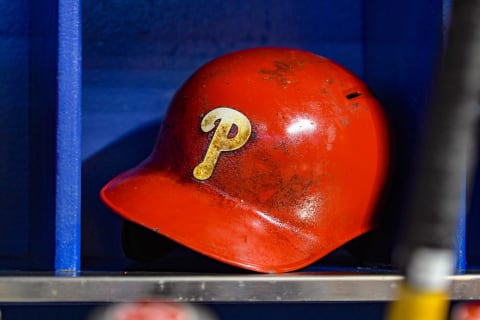
Ricky Jordan (1988, first base, ROY voting: 8th)
Jordan was drafted in the first round out of high school of the 1983 Amateur Draft. After five seasons in the Phillies minor league system, Jordan made his Major League debut on July 17, 1988. He got off to a fast start, going 1-for-2 with a home run in his first game. Jordan continued to hit well, finishing with a .308 average over 69 games with 15 doubles, 11 home runs and 43 RBI. His performance was enough to finish 8th in the Rookie of the Year vote.
The following season, Jordan set career highs in most major statistical categories. He hit .285 with 22 doubles, 12 home runs and 75 RBI. In 1990, Jordan was limited to 324 at-bats, but still maintained his gap power, hitting 21 doubles.
Jordan continued to thrive in a platoon the next two seasons, hitting .272 with 21 doubles and nine home runs in 301 at-bats in 1991 and .304 with 19 doubles in 276 at-bats in 1992. For the 1993 NL Championship team, Jordan’s playtime time went down, but still hit .289 with five home runs in 159 at-bats. In his last season in Philadelphia in 1994, Jordan hit .282 with 14 doubles and eight home runs in 220 at-bats.
He played in just 42 minor league games in the Angels and Mariners organizations in 1995 and 1996 and hit .250 in 28 at-bats for the Mariners. Jordan retired in 1997 after hitting .314 in 52 games at AA in the Pirates organization.
Jordan retired with a .281 average, 51 home runs, 304 RBI and 592 hits.
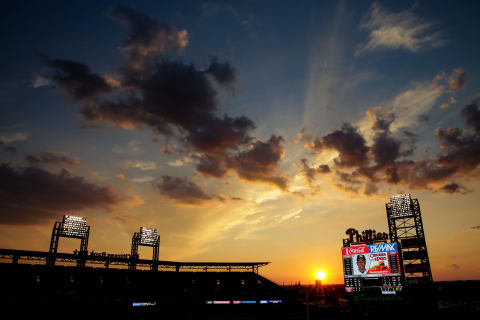
Wes Chamberlain (1992, right field, ROY voting: 5th)
Chamberlain was drafted out of high school by the Pittsburgh Pirates in 1984. After attending Jackson State University, he was selected again by the Pirates in the fourth round in 1987. After most of four seasons in the Pirates organization, Chamberlain was traded to the Phillies for Carmelo Martinez.
He made his Major League debut on August 31, 1990 and hit .283 with two home runs in 46 at-bats. During his rookie season of 1992, Chamberlain .240 in 101 games with 16 doubles, 13 home runs and 50 RBI. Although not spectacular numbers, they were good enough to earn him fifth place in Rookie of the Year voting.
Chamberlain played 34 games at AAA Lehigh Valley in 1992 and hit .258 with nine home runs and 41 RBI in 76 games with the Phillies. Platooning in right field with Jim Eisenreich in 1993, Chamberlain batted .282 with a career high 20 doubles, 12 home runs, 45 RBI.
He was traded to the Red Sox in the middle of 1994 for Paul Quantrill and Billy Hatcher. Chamberlain hit .256 in 51 games with Boston that season and just .119 in 42 at-bats in 1995. After playing in Japan in 1996, Chamberlain played for several Independent Leagues, earning All-Star honors in 2000 and 2003.
Chamberlain retired with a .255 hitter with 43 home runs and 167 RBI in 385 games.
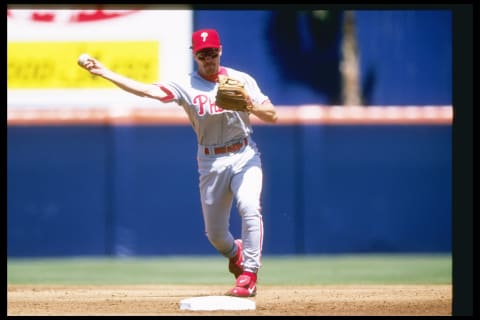
Kevin Stocker (1993, shortstop, ROY voting: 6th)
Stocker was drafted in the second round by the Phillies in 1991 out of the University of Washington. He went through the minor league system quickly, making his Major League debut on July 7, 1993. In 70 games , Stocker hit .324 with 17 extra-base hits, a .409 on-base percentage, 31 RBI and five stolen bases. Those numbers were good enough for sixth in Rookie of the Year voting.
The following season, Stocker played in 82 games, hitting a respectable .273 in 281 at-bats. Defensively, he was slightly below the league average in fielding percentage his first two seasons. However, Stocker vastly improved defensively, with fielding percentages well above average during his final few seasons in Philadelphia.
While his defense improved, Stocker’s batting average never approached his rookie season’s average. He hit only .218 in 1995, .254 in 1996 and .266 in 1997. Despite a mediocre average in his final season in Philadelphia, Stocker set career highs in hits, doubles and stolen bases.
Stocker was traded to the Tampa Bay Rays during the 1997 expansion draft for Bobby Abreu. Stocker hit .260 with nine home runs and 60 RBI in a little over two seasons with Tampa Bay before finishing his career with .197 in 70 games with the Angels in 2000.
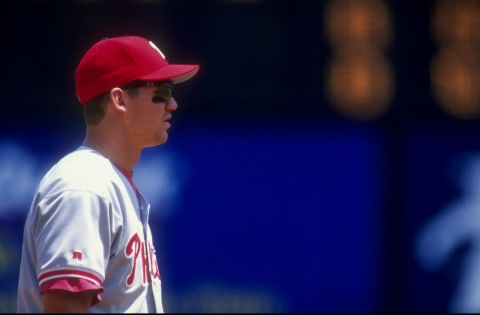
Scott Rolen (1997, third base, Rookie of the Year)
Rolen was drafted in the second round out of Jasper High School (Indiana) in 1993. He made his Major League debut on August 1, 1996 and hit .254 with four home runs in 37 games. Rolen was just average defensively his rookie season, but was strong at the plate. He hit .283 with 35 doubles, 21 home runs and 92 RBI, while stealing 16 bases. His efforts earned him Rookie of the Year honors.
He won his first of three Gold Glove awards with the Phillies in 1998, while increasing his power to 31 home runs, 45 doubles, 110 RBI and a .290 average. Rolen averaged 26 home runs and 91 RBI over the next three seasons, but had a tumultuous relationship with manager Larry Bowa and the management. As a result, the Phillies traded Rolen on July 29, 2002 which brought Placido Polanco, Mike Timlin and Bud Smith to the Phillies.
The 2002 season marked the first of five consecutive All-Star appearances, with four Gold Glove awards during the span. Rolen set a career highs in home runs (34), RBI (124) and batting average (.314) in 2004. In 2005, Rolen missed over 100 games with a shoulder injury, but rebounded to help the Cardinals win the 2006 World Series.
Following more problems with his shoulder in late 2007, he was traded to the Blue Jays in January 2008. Rolen spent a year and a half with the Blue Jays before being traded to the Reds in July 2009. Rolen enjoyed an All-Star season in 2010 and his final Gold Glove award in 2010 and finished his career with two mediocre seasons in 2011 and 2012.
Rolen retired with the third most Gold Glove awards by a third baseman behind only Brooks Robinson and Mike Schmidt. Combine his defense with 316 home runs, 2077 hits and 1287 RBI, Rolen should receive decent Hall of Fame consideration.
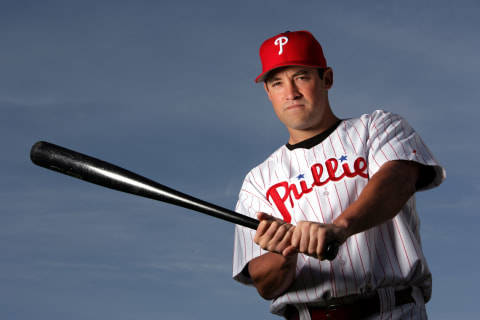
Pat Burrell (2000, left field, ROY voting: 4th)
After being selected by the Phillies in the first round in 1998, Burrell made quick work through the minor leagues, batting over .300 with 36 home runs in 164 games. In his rookie season of 2000, Burrell displayed a glimpse of his power, hitting 18 home runs with a .260 average and .822 OPS in 111 games. He got Rookie of the Year consideration, finishing fourth in the voting.
The following season, Burrell started a string of eight consecutive seasons hitting at least 20 home runs when he belted 27 with 89 RBI. He had his best season in 2002, hitting 39 doubles, 37 home runs and a .282 batting average, all career highs.
In 2005, Burrell earned seventh place votes in the MVP race when he hit .281 with 32 home runs and a career high 117 RBI. The 2007 season was the first of two consecutive seasons with at least 30 home runs. In fact, Burrell was a key component to the 2008 World Series championship team, hammering 33 home runs with 86 RBI.
Perhaps Burrell’s biggest hit in his career was in the seventh inning of Game 5 of the 2008 World Series. With the score tied, he ripped a double, which led to the go ahead and what proved to be the winning run.
Burrell became a free agent following the season and signed with the Rays, here he struggled for the most part. He hit just .218 with 16 home runs and 77 RBI in 146 games before being designated for assignment. A few days later, he signed with the Giants and hit .252 with 25 home runs in 188 games. Burrell signed a one-day contract with the Phillies in 2012 to officially retire with the team with a career average of .253 with 297 home runs.

Jimmy Rollins (2001, shortstop, ROY voting: 3rd)
The Phillies all-time hits leader and greatest shortstop in franchise history started his career with a bang. After a .321 after in 14 games in 2000, Rollins led the league in triples (14) and stolen bases (46) his rookie season. In addition, he hit .274 with 29 doubles, 14 home runs and 54 RBI. He made the All-Star team, had consideration for MVP and finished third in Rookie of the Year voting.
Rollins made his second All-Star team the following season, once again leading the league in triples. He also led the league in triples in 2004 and in his MVP season of 2007. During that season, he hit .296 with a league-leading 139 runs, 212 hits, 38 doubles, 20 triples, 30 home runs, 94 RBI and 41 stolen bases.
Although his power production dropped considerably in 2008, Rollins stole 47 bases and won his second consecutive Gold Glove award for the World Championship team. Rollins regained his power in 2009, hitting 43 doubles and 21 home runs, helping lead the team to their second straight World Series appearance.
Rollins had his final 20+ home run season in 2012 and also stole 30 bases for the last time. In addition, he won his fourth and final Gold Glove award. He was traded to the Dodgers on December 19, 2014 for two Minor League players. Rollins struggled to a .224 average with the Dodgers in 2015 and .221 with the White Sox in 2016. Although invited to spring training by the Giants in 2017, Rollins didn’t make the club, being released on March 31, 2017.
Rollins retired with 2455 hits, 1421 runs, 511 doubles, 236 home runs and 470 stolen bases.
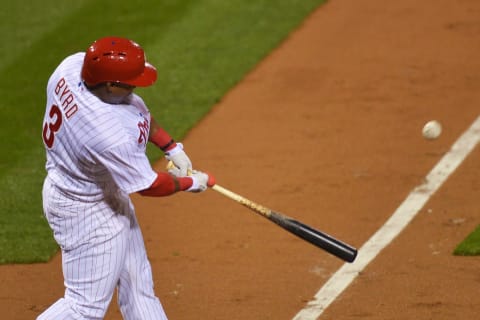
Marlon Byrd (2003, center field, ROY voting: 4th)
Byrd made his Major League debut on September 8, 2002 and hit .229 with a home run in ten games. During his rookie season of 2003, Byrd played in 155 games. Thrown into the starting lineup with little experience, Byrd hit .311 with 28 doubles, seven home runs, 45 RBI and 11 stolen bases. His play was good enough for fourth place in Rookie of the Year voting.
Byrd’s performance dropped considerably the following season and was traded to the Nationals for Endy Chavez. After two mediocre seasons in a reserve role, Byrd was designated for assignment. He signed with the Texas Rangers as a free agent at the end of 2006.
His playing time and production increased with the Rangers. Byrd’s best season in Texas was 2009 when he hit .283 with 43 doubles, 20 home runs and 89 RBI. After become a free agent following the season, Byrd signed with the Cubs. He made his first an only All-Star appearance in 2010, but once again his production dwindled and was traded to the Red Sox in April 2012.
Byrd bounced around the league late in his career, playing for the Red Sox, Mets, Pirates, Phillies, Reds, Giants and Indians over his final five seasons. He was quite productive in his second stint with the Phillies, hitting 25 home runs with 85 RBI in 2014.
Byrd retired with 1534 hits, 159 home runs and a .285 batting average.
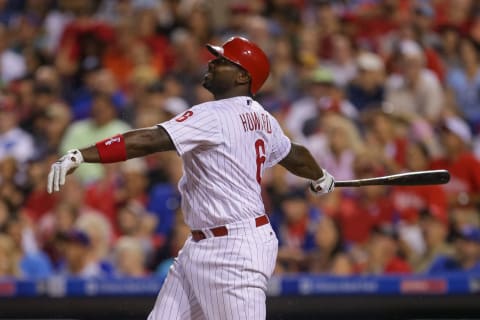
Ryan Howard (2005, first base, Rookie of the Year)
The top offensive first baseman in franchise history, Howard played in 14 games in 2004, hitting two home runs in 39 at-bats. He got his opportunity in full time the following season when Jim Thome went down with an injury. In 88 games, Howard hit .288 with 22 home runs and 63 RBI, winning the Rookie of the Year award.
Howard followed with a career season, setting a franchise record for home runs in a season with 58. He led the league in home runs and RBI with 149, while batting .313. Howard not only made the All-Star team but won MVP honors.
That started a string of four consecutive seasons with at least 40 home runs and 130 RBI. Howard led the league in home runs and RBI for the 2008 World Series championship team, nearly claiming his second MVP, finishing second in the balloting.
After leading the league in RBI with 146 in 2009, Howard’s production started to decline. Even so, Howard still hit over 30 home runs and 100 RBI in both 2010 and 2011. Unfortunately, Howard tore his Achilles tendon running out the final out of the 2011 NLDS against the Cardinals.
He was limited to 71 games that season, hitting just .219 with 14 home runs. Howard also struggled with injuries in 2013 after tearing his left meniscus, limiting him to 11 home runs and a .266 average in 80 games.
Howard continued to show power over his final three seasons with the Phillies, hitting at least 20 home runs each season. The Phllies declined the option for Howard following the 2016, making him a free agent. Although Howard signed Minor League contracts with the Braves and Rockies in 2017, Howard never made it back to the Major Leagues.
Howard retired with a .258 batting average, 382 home runs and 1194 RBI.
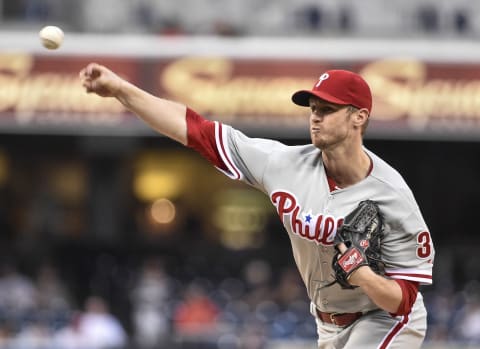
Kyle Kendrick (2007, starting pitcher, ROY voting: 5th)
Kendrick was drafted by the Phillies in 2003 out of Mount Vernon High School in Washington. After making his way through the Minor League system, Kendrick made his Major League debut on June 13, 2007. During his rookie season, Kendrick went 10-4 with a 3.87 ERA in 20 starts. His play was good enough to earn him fifth place votes for Rookie of the Year.
The following season Kendrick won 11 games but had a high ERA of 5.49. He spent most of 2009 at AAA Lehigh Valley, pitching to an ERA of 3.34 in 24 starts. In nine Major League games that season, he went 3-1 with a 3.42 ERA.
Kendrick spent five more seasons with the Phillies, averaging ten wins per season. His ERA remained under four in 2011 and 2012, however hovered in the mid to upper 4’s in 2010, 2013 and 2014.
After eight seasons with the Phillies, Kendrick signed a one-year control with the Rockies, where he struggled to a 7-13 record and 6.32 ERA. He then signed a Minor League contract with the Braves at the end of 2015 but was released in March 2016. Getting another chance with the Angels, Kendrick pitched for their AA A team but failed to make the Majors.
Kendrick hasn’t pitched in the Majors since going 0-2 with a 12.96 ERA for the Red Sox in two starts in 2017.
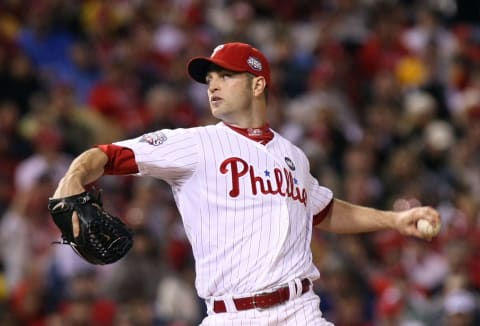
J.A. Happ (2009, starting pitcher, ROY voting: 5th)
Happ made his Major League debut in 2007 but maintained rookie status in 2009 due to the fact he made only nine appearances combined in 2007 and 2008. As a rookie for the defending World Series champions, Happ did well. He appeared in 35 games, 23 as a starter, wining 12 and losing only four with a 2.93 ERA. Happ had two shutouts, which tied for the league-lead. Recognized for his efforts, Happ finished second in Rookie of the Year voting.
Despite his success in 2009, Happ was traded to the Astros in July 2010 for Roy Oswalt. With the Astros, Happ went 5-4 with a 3.75 ERA in 13 games. However, he struggled to find his form in 2011 and 2012, going a combined 16-26 with an ERA around five with the Astros and Blue Jays.
Happ had a bonce back season of sorts in 2014, winning 11 with a 4.22 ERA with Toronto. After a solid season with the Mariners and Pirates in 2015, Happ was back with the Blue Jays in 2016. That proved to be a career season for Happ, going 20-6 with a 3.18 ERA, finishing sixth in the Cy Young award voting.
This past season, Happ made his first All-Star appearance, going 17-6 overall (including 7-0 with the Yankees) and an ERA of 3.65.
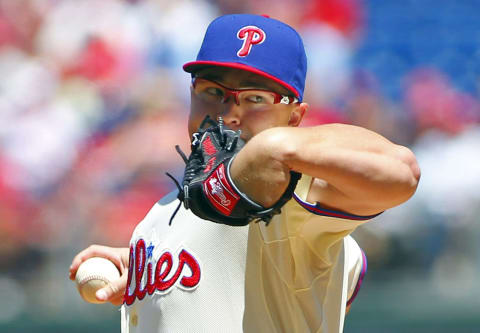
Vance Worley (2011, starting pitcher, ROY voting: 3rd)
Worley made five appearances in 2010, going 1-1 with a 1.38 ERA. During his rookie campaign of 2011, Worley turned some heads, posting an 11-3 mark with an ERA of 3.01. He allowed only 116 hits in 131 1/3 innings, while striking out 119. The performance earned him enough votes to finish third for Rookie of the Year.
In 2012, Worley’s effectiveness dropped considerably, winning just six of 15 decisions with a 4.20 ERA. He was traded on December 6 of that year along with Trevor May to the Twins for outfielder Ben Revere.
The drop from 2011 to 2013 was astronomical, as Worley went 1-5 with a 7.21 ERA in 10 starts. He allowed 82 hits and nine home runs in just 48 2/3 innings and was traded to the Pirates in March 2014. After spending time at AAA Indianapolis, Worley was effective for the Pirates, going 8-4 with a 2.85 ERA and his only Major League shutout to date.
After one more season in Pittsburgh, Worley was claimed off waivers by the Orioles. He was solid in 35 games, mostly in relief, posting an ERA of 3.53 in 86 2/3 innings. A free agent following the season, Worley signed with the Marlins, but had little success, pitching to a 6.91 ERA in 24 games.
Worley made four starts in the Mets organization before being placed on the disabled list and was later released.
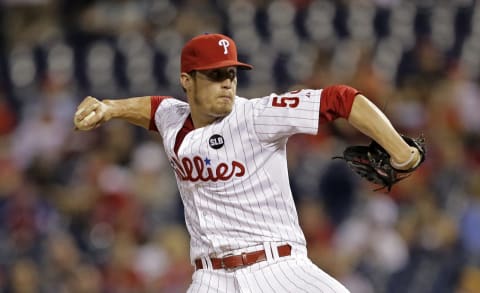
Ken Giles (2014, relief pitcher, ROY voting: 4th)
Giles was drafted by the Phillies in the seventh round in 2011 and after three plus seasons in the Minor Leagues, made his debut on June 12, 2014. During a little over a half a season, Giles pitched to a 1.18 ERA over 45 2/3 innings, striking out 64. His dominant performance earned him enough votes to finish fourth for Rookie of the Year.
He began the 2015 season as the setup man, but became the closer after the Phillies traded Jonathan Papelbon to the Washington Nationals in late July. Giles responded favorably, going 6-3 with 15 saves and a 1.80 ERA, striking out 87 in 70 innings.
Despite having success with the Phillies, he was traded to the Astros in December 2015 for five players, including Vince Velasquez. After a 102 strikeout season in just 65 2/3 innings in 2016, Giles saved 34 with a 2.30 ERA in 2017.
Giles was traded to the Blue Jays on July 30, 2018. Although he had 26 saves for the season, Giles had a relatively high ERA for a closer of 4.65.
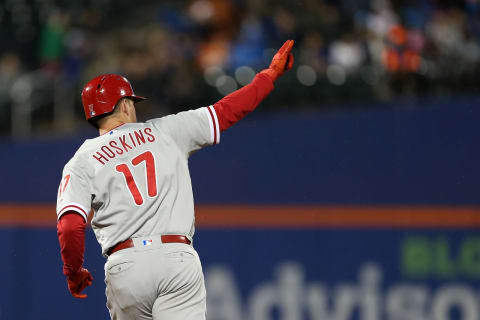
Rhys Hoskins (2017, left field, ROY voting: 4th)
Hoskins hit 26 home runs over his first two Minor League seasons before taking off at AA Reading in 2016, belting 38 home runs in 135 games. After blasting another 29 home runs in 115 games at AA Lehigh Valley in 2017, Hoskins was called up to the Phillies, making his Major League debut on August 10.
What Hoskins did over the last month and half of the season was historic. He got his first Major League hit on August 13 and his first two home runs the next day. Hoskins became the fastest to nine home runs, ten home runs and then 11 home runs in just 18 games covering 64 at-bats. On September 14, Hoskins became the fastest in Major League history to reach 18 home runs, doing so in only 34 games. Even though Hoskins didn’t homer over his final 16 games, Hoskins finished with 18 home runs and 48 RBI, good for fourth in Rookie of the Year voting.
This past season, Hoskins set a franchise record as the fastest to 30 career home runs, doing so in 120 games, 12 games faster than the previous record held by Chuck Klein. Hoskins also took part in the MLB Home Run Derby, launching 37 home runs, although eliminated in the second round by Kyle Schwarber.
Hoskins ended the season with a .246 average, 34 home runs, 96 RBI and an .850 OPS.